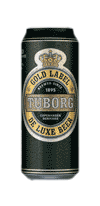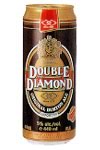|
Although there are essentially only two types of beer (ale and lager), there are a number of styles that fall under the two categories.
 Lagers Lagers
The word lager is derived from the German verb “lagern,” which means "to store". During the late middle ages, before the days of refrigeration, fermentation was a hit-or-miss affair, especially during the hot summer months. To ensure a supply of beer for the summer, brewers in the Bavarian Alps stored kegs of spring brew in icy mountain caves. As the beer slowly aged, the yeast settled, creating a drink that was dark but clear and sparkling with a crisper, more delicate flavour. In 1842, lager acquired its familiar golden colour when a brewery in Pilsen, Czechoslovakia perfected a pale, bottom-fermented version of the beer. Lagers typically take more time to brew and are aged longer than ales. Lagers are best enjoyed at cooler-than-room temperature.
Ale
 Although the term 'ale' covers a fascinating variety of styles, all ales share certain characteristics. Top-fermentation and the inclusion of more hops in the wort gives these beers a distinctive fruitiness, acidity and a pleasantly-bitter seasoning. All ales typically take less time to brew and age then lagers and have a more assertive, individual personality, though their alcoholic strength may be the same. Ales are best enjoyed at room temperature or slightly warmer. Although the term 'ale' covers a fascinating variety of styles, all ales share certain characteristics. Top-fermentation and the inclusion of more hops in the wort gives these beers a distinctive fruitiness, acidity and a pleasantly-bitter seasoning. All ales typically take less time to brew and age then lagers and have a more assertive, individual personality, though their alcoholic strength may be the same. Ales are best enjoyed at room temperature or slightly warmer.
The following lists styles of beer, generally from the most delicate-flavored to strong-flavored "specialty" brews.The essential difference in beer is the content of the brew. Just as each winery has a "signature" that wine connoisseurs can readily detect, certain geographical areas also provide "signature" brews that are just as distinct. The basis for different styles is usually found in the basic ingredients of the brew that are indigenous to a specific area.
American Light Lager This style of beer is the result of the growth of national breweries, and their ability to brew a beer with wide appeal and a competitive price. It is essentially a pilsner-style lager, brewed with significant quantities of grain other than barley malt; a slightly sweet, lightly hopped, straw-colored, effervescent beer.
Pilsner A light-straw colored, full-bodied, lagered, bottom-fermented beer named after the town of Pilsen (in what was then known as Bohemia), where it was first brewed in 1842. It quickly became a popular style because it was so different from the amber brews that were the norm at that time.
British Bitter This top-fermented classic ale style offers a deep, rich brown or ruby color with a malty, very lightly hopped flavor. True bitter is only lightly carbonated.
Pale Ale Pale ale, another classic British top-fermented ale style, has more hop flavor than the bitter style, but not as much as India pale ale.
Indian Pale Ale India pale ale was developed as a high-gravity, well-hopped brew, which enabled it to last the voyage from England’s breweries to overseas locales (thus its name).
Vienna Lager This style was the rage in Vienna at the turn of the 19th century. Then it fell from fashion and left Europe for the warmer climate of Mexico. Today, the only true Vienna lager is Dos Equis, but with the growth of the specialty beer market it may not hold its special place for long.
Brown Ale Bown ale is a traditional British, top-fermented ale, similar to a pale ale, but sweeter and darker.
Scottish Ale This is a high-alcohol brew made with Scottish malted barley. The flavor includes hints of caramel and smoke, and less hops taste than English brews.
Strong Ale Also called Old Ale this high-alcohol brew is noted for its dark color and sweet flavor.
Barleywine Barleywine is a very dark, almost opaque ale. The term "barleywine" is a fairly new -- once called "Strong Ale," this is the most alcoholic style of beer. The addition of a healthy amount of hops forms a powerful flavor triad of sweet malt, bitter hops and warm alcohol.
Bock Beer Similar to strong ale, this style uses bottom fermenting yeast and is "lagered" (aged) for at least a month.
Porter and Stout Whether dry or sweet, flavoured with roasted malt barley, oats or certain sugars, stouts and porters are characterized by darkness and depth. Both types of beer are delicious with hearty meat stews and surprisingly good with shellfish. The pairing of oysters and stout has long been acknowledged as one of the world's great gastronomic marriages.
Wheat Beer This top-fermented beer contains more than half wheat. Hallertau hops are used for both bittering and aroma. Lager yeast is used and the beer is allowed to lager for approximately two to three weeks at just below freezing temperatures.
Belgian Styles
Flanders Red Ales Considered the best of the “red beers,” Rodenbach is brewed from four different malts. Five different strains of yeast are used in the fermentation process.
Lambic Typically served in a champagne flute, this beer is usually sold in 750 mL bottles. Lindeman's Kriek, a good example of the style, is a top-fermented cherry flavored lambic (70 per cent malted barley and 30 per cent unmalted wheat), with a rose color. It has an aroma of cherries and is sparkling, with a dry finish. The acidic flavor of the Lambic blends well with the cherry flavor.
Belgian Strong Brewed by the Moorgat brewery in Belgium, Duvel is seen as the quintessential pale Strong Ale, with a flavor that is complex and deep. It is made with Danish summer barley malt, whole flower Styrian and Saaz hops. Duvel undergoes three fermentations. The first is warm, the second cold, and the final one takes place in the bottle, lasting five weeks.
Trappist Dark brown with a ruby hue, three types of trappist beers are produced by Chimay: Premier Chimay (red), Cinq Cents (white), and Grand Reserve (blue). The red, as well as the blue, has a fruity taste, with a soft, full, deep body. The white Chimay has a stronger hops flavor and a drier finish, with a quenching hint of acidity. It also has a paler color, more amber than ruby red.
Specialty Beers
Steam Beer In the 19th century "steam beer" was a nickname for local beers that were fermented with lager yeast, at ale yeast temperature, producing beers with ale-like character. It may also have been common practice to "top off" kegs of beer with beer that had not finished its first fermentation. The result was an in-keg fermentation that produced high levels of natural carbonation. With no refrigeration to control this fermentation a freshly tapped keg would produce copious amounts of foam or "steam."
Herbed/Spiced Every year, since 1975, Anchor has brewed a Christmas Ale. It is produced in small quantities and is available only from late November until early January. Each year the recipe is changed and there is a special label designed around the tree, a traditional symbol of renewal. Properly refrigerated, this beer remains drinkable for years.
Smoked Germany’s Kaiserdom, a good example of this style, is brewed from Bavarian barley that has been roasted over a fire of moist beech wood logs. Whole Hallertau hops are used to provide flavor and aroma. After bottom fermenting, the beer is lagered for three months. The finished product is a dark-colored, smoky-flavored beer.
Otoberfest A fairly strong beer, Paulaner Marzen’s brew starts with a two-mash process using dark- and light- colored brewing malt from two-row Bavarian summer barley. Hallertau hops are used for both bittering and aroma. Lager yeast is used and the beer is allowed to lager for approximately four weeks at just-below-freezing temperatures.
Dry “ Dry” refers to the amount of residual sugar left in a beer following fermentation. This type of beer is fermented for longer than normal brews so that practically all of the residual sugar is converted into alcohol. The result is a beer which consumers describe as having a crisp flavour, clean finish and very little aftertaste.
|
